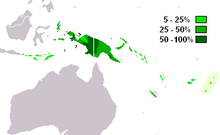Haplogroup M (Y-DNA)
| Haplogroup M-P256 | |
|---|---|
 |
|
| Possible time of origin | 32,000-47,000 years BP (Scheinfeldt 2006) |
| Possible place of origin |
Wallacea (eastern Indonesia) or New Guinea |
| Ancestor | K2b1 |
| Defining mutations | P256 |
| Haplogroup M-M4 | |
|---|---|
| Possible time of origin | 8,200 [3,800–20,600] years BP (Kayser 2003) |
| Possible place of origin | Southeast Asia - Melanesia |
| Ancestor | M-P256 |
| Defining mutations | M4, M5/P73, M106, M186, M189, M296, P35 |
Haplogroup M, also known as M-P256 and Haplogroup K2b1b (previously K2b1d) is a Y-chromosome DNA haplogroup. M-P256 is a descendant haplogroup of Haplogroup K2b1, and is believed to have first appeared between 32,000 and 47,000 years ago (Scheinfeldt 2006).
M-P256 is the most frequently occurring Y-chromosome haplogroup in West Papua and western Papua New Guinea.(Kayser 2003). It is also found in neighbouring parts of Melanesia, Indonesia and among indigenous Australians.
It and Haplogroup S (B254) are the only primary subclades of K2b1, also known as haplogroup MS.
This phylogenetic tree of haplogroup subclades is based primarily on the trees published by ISOGG in 2016 (ISOGG 2016) and YCC in 2008.(Karafet 2008)
The paragroup M-P256* is found at low incidences in New Guinea (6.3%) and Flores (2.5%).
Found frequently in New Guinea and Melanesia, with a moderate distribution in neighboring parts of Indonesia, Micronesia, and Polynesia.
An extreme geographical outlier was apparently identified in a 2012 study, which reported a Hazara individual from Mazar-e Sharif, Afghanistan, with M1 among a sample of 60 males from Mazar-e Sharif.(Haber 2012). The Hazara individual carried the SNP M186 (which is believed to be equivalent to M4).
...
Wikipedia
